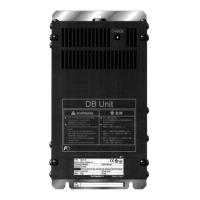TROUBLESHOOTING
Chap 6
6.1 Protective Function
In order to prevent system down or to shorten a downtime, FRENIC-Ace is provided with various protective
functions shown in Table 6.1-1 below. The protective functions marked with an asterisk (*) in the table are disabled
by factory default. Enable them according to your needs.
The protective functions include, for example, the “heavy alarm” detection function which, upon detection of an
abnormal state, displays the alarm code on the LED monitor and causes the inverter to trip, the “light alarm”
detection function which displays the alarm code but lets the inverter continue the current operation, and other
warning signal output functions.
If any problem arises, understand the protective functions listed below and follow the procedures given in
Sections 6.2 and onwards for troubleshooting.
Table 6.1-1 Abnormal States Detectable (“Heavy Alarm” and “Light Alarm” Objects)
Protective function Description
Related
function code
“Heavy alarm” detection
This function detects an abnormal state, displays the corresponding alarm
code, and causes the inverter to trip. See “Table 6.3-1 Various failure
detections (Heavy failure objects)” for alarm codes. For details of each alarm
code, see the corresponding item in the troubleshooting in Section 6.3 .
The inverter retains the last four alarm codes and their factors together with
their running information applied when the alarm occurred, so it can display
them.
H98
“Light alarm” detection*
This function detects an abnormal state categorized as a “light alarm,” displays
l-al
and lets the inverter continue the current operation without tripping.
Details of light alarms are selectable. Selectable details (codes) are shown in
“Table 6.3-1 Various failure detections (Heavy failure objects).”
See Section 6.4 for the confirming method and releasing method of the light
alarms.
H81
H82
Stall prevention
When the output current exceeds the current limiter level (F44) during
acceleration/ deceleration or constant speed running, this function decreases
the output frequency to avoid an overcurrent trip.
F44
Overload prevention
control*
Before the inverter trips due to a cooling fin overheat (
0h1
) or inverter
overload (
0lu
), this function decreases the output frequency of the inverter to
reduce the load.
H70
Anti-regenerative control*
If regenerative energy returned exceeds the inverter's braking capability, this
function automatically increases the deceleration time or controls the output
frequency to avoid an overvoltage trip.
H69
Deceleration
characteristics*
(Improvement of braking
performance)
During deceleration, this function increases the motor energy loss and
decreases the regenerative energy returned to avoid an overvoltage trip (
0u
).
H71
Reference loss detection*
This function detects a frequency reference loss (due to a broken wire, etc.),
issues the alarm, and continues the inverter operation at the specified
frequency.
E65
Automatic lowering of
carrier frequency
Before the inverter trips due to an abnormal surrounding temperature or output
current, this function automatically lowers the carrier frequency to avoid a trip.
H98
Motor overload early
warning*
When the inverter output current has exceeded the specified level, this
function issues the “Motor overload early warning” signal before the thermal
overload protection function causes the inverter to trip for motor protection
(Only for the 1st motor).
E34
E35
Retry*
When the inverter has stopped because of a trip, this function allows the
inverter to automatically reset and restart itself.
The number of retries and the latency between stop and reset can be
specified.
H04
H05
Forced stop*
Upon receipt of the “Force to stop” terminal command STOP, this function
interrupts the run and other commands currently applied in order to forcedly
decelerate the inverter to a stop state.
H56
Surge protection
This function protects the inverter from a surge voltage between main circuit
power lines and the ground.
-
Momentary power failure
protection*
• If a momentary power failure for 15 ms or longer occurs, a protective
operation (inverter stop) is activated.
• When momentary power failure restart is selected, the inverter restarts
automatically after voltage restoration within a set-up time (momentary
power failure permissible time).
F14

